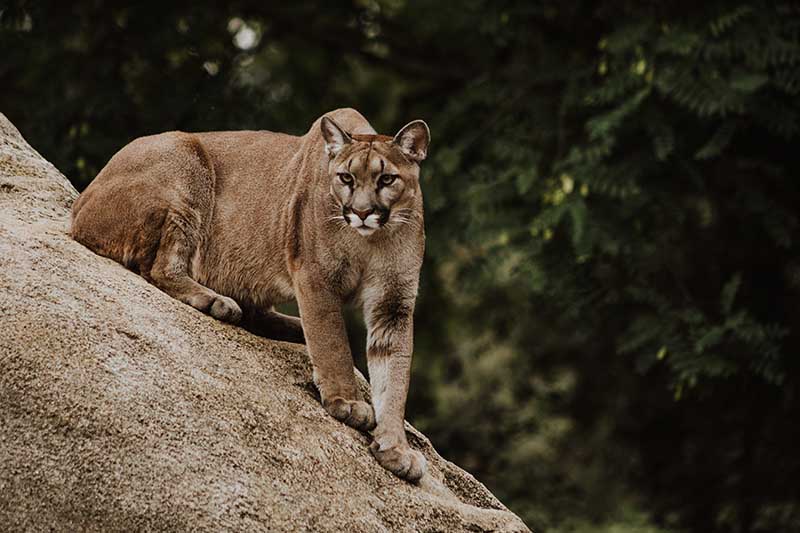You're likely to come across lots of wildlife on your trekking adventures, such as birds, deer, squirrels, and even a fox. These critters are usually harmless and exciting to see on the trail. But what about larger, predatory animals?
While most wild animals avoid human contact at all costs, it's still important to know what to do if you ever do come across a large, potentially dangerous, animal. That's why we've compiled this list of helpful information and action to take if you find yourself face-to-face with one of North America's territorial creatures.
Featured Photo: Bull Elk (photo by Jeffrey Rolinc)
Snakes
You should always leave snakes alone, even if they look “harmless”. The main reason for this is that many snakes have doppelgangers.
For example, common water snakes are often mistaken for copperheads. They grow to about the same length and have very similar markings and coloration. But, one is venomous and one is not. While one might cause an infection at worst if it bites you, the other can land you a trip to the ER.
This is why, unless you're a trained herpetologist, you should never handle a snake. In fact, you should avoid it altogether by giving it a wide berth or waiting until it moves on.
Especially in the desert, it's also a good idea to keep your gear, namely shoes, inside your tent at night. Snakes seek warmth since they are cold-blooded and love hiding places. You don't want to get up in the morning to find a western diamondback rattlesnake in your boot! Also, be sure to zip up your tent well at night to prevent them, spiders, and scorpions from sneaking in.
Spiders
There's not much you can do to avoid these critters. However, it's always a good idea to check your clothing and pack before you put them back on, both after breaks and when you get going in the morning. Especially in arid regions, spiders like to congregate under tents and rainflies. Just be aware of this when you go to tear down your tent. You might want to give it a good shake to knock any off.
Spiders generally like to hide in dark places and also seek heat. It's also a good idea to check under picnic tables before sitting down. Brown recluse and black widow spiders seem to particularly like these hiding spots.
Cougars

Source: Unsplash
These large predatory cats are common in the western states. But, it's still rare to encounter one despite the viral videos of hikers and cyclists capturing them on video.
Cougars are loners, keep to themselves, and try to avoid people. However, if they feel threatened, they can quickly become agitated.
Here's what to do if you ever come face-to-face with a mountain lion.
- Make yourself look as big as possible. Never crouch down. Raise your arms above your head and wave them. Make a lot of noise.
- If possible, stand up on a tree stump, rock, etc to make yourself look even bigger.
- Never turn away from it or even look away.
- Never try to run away. This can trigger their chase response. You cannot outrun or outclimb a cougar. They can run up to 50mph. The average human can run about 7mph. Cougars can jump 18ft vertically from a sitting position and 40ft horizontally.
- If you have small children or pets, place them behind you or pick them up if you can do so without crouching much.
- Back away slowly, but never take your eyes off the animal.
- If it does attack, fight back. People have fended off cougars by being aggressive and making the animal realize it's made a bad choice in attacking. Also, try to keep it away from your neck. This is their typical “kill spot” when hunting prey.
Deer, Elk, and Moose
You should treat these three alike creatures similarly. First and foremost, give them space and back away slowly. If they do become aggressive and act like they may charge you, put an obstacle between you and the animal, such as a tree. If any of them do begin to charge, run away or try to climb a tree.
If a deer is attacking you and you can't get up to run, it is recommended that you play dead. With elk and moose, however, it is best to get up and keep running. Not only are their antlers a threat, but their hooves as well. A bull moose can weigh up to 1,400lbs! Also, unlike big cats, direct eye contact should be avoided with these animals if they are acting aggressively.
Keep in mind that any wild animal, those in the deer family included, are likely to become provoked more easily at two specific times of year. Males can be aggressive in the fall during rutting season. Females can become very protective of babies during the spring.
Bison
With the amazing rebound these woolly giants are seeing, it's a good idea to know a little about them and how to treat them. This is especially true if you will be hiking through some of the plains states.
It can be easy to mistake these creatures for gentle giants. Most of the time, they are. Weighing in at up to 2,200lbs, bison spend most of their days wandering around the prairies. But don't let their big size fool you. They can run up to 40mph!
Like bears, be careful to not startle them. If you see them before they see you, make noise to alert them of your presence. Don't make any sudden movements, such as running. Give them plenty of space and do not approach them. If they do charge you, try to put an obstacle between you and the animal. Anything at all that might deter them. If there are trees nearby, make a beeline for them and climb one.
Bobcats, Coyotes, and Wolves
You should treat these animals similarly to cougars if you come into close contact with one. Stand tall, don't crouch, make a lot of noise, throw things if necessary, and do NOT run or turn your back on the animal. Put small children and animals behind you. Back up slowly away from the animal.
Like mountain lions, these animals are also known for going for the neck when hunting prey. So, if the animal does attack you, fight back and keep it away from this vulnerable area of your body as best you can.
Mountain Goats

Source: Unsplash
Here's something you may not know: Mountain goats are attracted to the salt in human urine. So, make sure to relieve yourself well off the trail so you're not accidentally attracting goats to it and other hikers. If you do see a goat, give it space and wait for it to pass. If that doesn't work and it gets closer, start making lots of noise and wave a piece of clothing/hat/etc. If that doesn't work, throw rocks. If the goat won't give up, retreat. And if it does charge you, you can buy yourself some time by grabbing its horns. Rest assured, though, mountain goat attacks are extremely rare.
Wild Boar
Unless you live or hike in the southern states, you probably don't give feral pigs much thought. But these animals can cause not only a lot of damage to farms, but to people too if you're not careful. Their main weapon is their tusks. But, they are also surprisingly muscular and can run up to 30mph.
If you encounter one, give it space and back away slowly like you would any wild animal. Feeling trapped can kick in their defense response. If you find one charging you, run and try to find higher ground by climbing a tree, boulder, or even a car.
Dealing with Marmots, Pika, and Other Rodents

Source: Unsplash
Nothing can ruin an otherwise awesome backpacking trip like waking up one morning to find that some kind of rodent made a midnight snack of your food. To add insult to injury, they also chewed through the straps on your pack and you're miles away from the trailhead! (Why the straps? Some of these little critters are attracted to the salt left on your pack from sweating.) You may have heard of people still hanging bear bags in areas where it's not required or where there isn't a huge bear population. This is the biggest reason why.
Marmots, pika, mice, squirrels, chipmunks, and other small rodents and mammals can wreak havoc on your supplies overnight if you don't take precautions. Here are some tips on keeping these cute, but curious, critters from ruining your good time.
- Use bear lockers and other permanent food storage vestibules when available. As long as they are in good condition, they help to keep out more than bears.
- Use a bear or ratsack and hang it at least a few feet away from tree trunks and off the ground. These hangs do not have to be as extreme as bear hangs for obvious reasons. Be sure to use heavy-duty cordage. Little critters have sharp teeth and have been known to bite through hanging rope! An even better tip is to use some heavy-duty fishing line for your hang since rodents can't get a hold of it.
- It's worth noting that some wilderness areas require bear canisters instead of bags. Other than taking up more room in your pack, these actually make more sense. They are much harder for sharp animal teeth to gnaw through.
- As long as you remove all food and other scented items, you should be fine to leave your backpack inside your tent or its vestibule.
To deter critters from getting near your campsite to begin with:
- NEVER leave food, or even eat, inside your tent.
- Cook your food away from your sleeping area.
Final Thoughts
It's always a good idea to hike with at least one other person. They can provide a valuable set of extra eyes to look out for danger. Plus, they may even be able to help you fend off an animal attack!
It's also worth noting that dogs are not allowed in certain areas due to the wildlife. Just their presence can agitate animals even more, especially cougars, bears, and wild canine species. If you do bring your furry friend, be sure to keep him or her on a leash for both their safety and that of the wildlife.
Wondering why we didn't cover one of the largest predatory mammals in North America, the bear? That's because we already have an article dedicated specifically to backpacking in bear country! Click here to read valuable tips on staying safe in bear territory.
Have you ever had a close encounter with a large animal? What tips would you share to stay safe? We'd love to hear your ideas in the comments section below!
Read Next
Looking for more backpacking-related info? Check out the following blog posts:
Top 18 Wilderness Survival Skills for Backpackers
How to Handle Emergencies on the Trail
Top 5 Most Useful Knots on the Trail
Looking for trip ideas? Check out these amazing backpacking trips by visiting The Trailhead, our interactive hike map. It contains a curated list of dozens of hikes, each with a detailed write-up.
Finally, check out our comprehensive list of backpacking articles that cover just about everything there is to know about backpacking. If you're just starting out, our Backpacking 101 section covers all the basics. If you already have a few trips under your belt, you can find more advanced topics covered in our Expert Articles.













Leave a comment